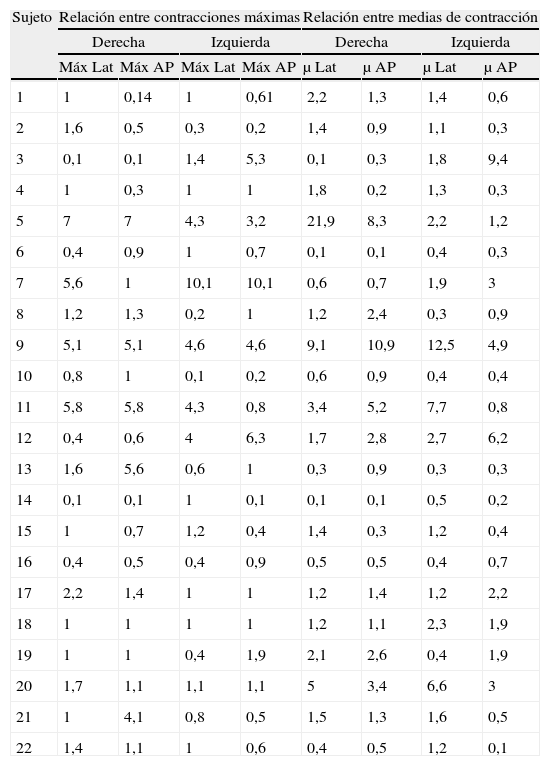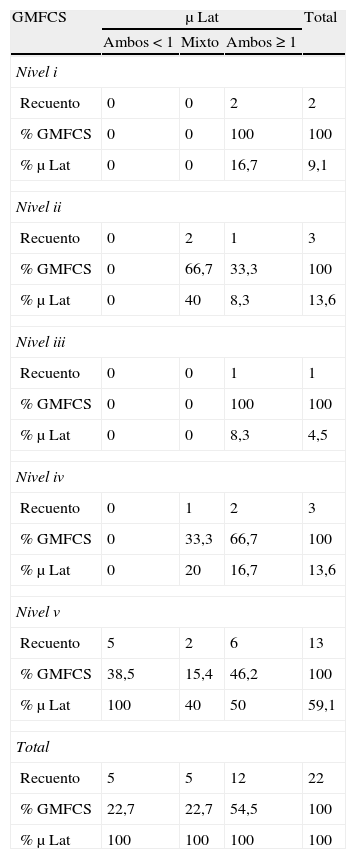Dentro del mecanismo de control postural, el reflejo vestibulocervical (RVC) es responsable del posicionamiento de la cabeza en el espacio. A pesar de observarse en individuos con parálisis cerebral (PC) déficit en el control cefálico apenas existen estudios que concreten la implicación del RVC en el nivel de la función motora. Así, se plantea como objetivo de este estudio asociar en una población con PC la respuesta muscular cervical obtenida ante estimulación vestibular con el nivel de la función motora gruesa.
MétodosMediante electromiógrafo de superficie, se registró en 22 individuos con PC, clasificados según el nivel de la Gross Motor Function Classification System (GMFCS) la actividad muscular del grupo extensor cervical ante desequilibrios anteroposteriores y laterales comparándola con la obtenida en sedestación sin desestabilizaciones.
ResultadosEn los sujetos pertenecientes a los niveles i, ii y iii de la GMFCS, no se observan alteraciones bilaterales de la respuesta cervical a estímulos vestibulares, ya sean estos laterales ya anteroposteriores. Para el nivel iv hay casos con alteraciones bilaterales en las respuestas a los desequilibrios anteroposteriores y para el v tanto para laterales como para anteroposteriores.
ConclusionesLas alteraciones bilaterales del RVC podrían ser, en un porcentaje de sujetos con gran limitación de la movilidad (grupos iv y v de la GMFCS), uno de los principales factores responsables del déficit motor. Por otro lado, las alteraciones unilaterales del RVC parecen afectar a la calidad e independencia de la marcha pero no a la capacidad de llevarla a cabo.
Within the postural control mechanism, the vestibulocollic reflex (VCR) is responsible for the positioning of the head in space. Although deficits in head control have been observed in individuals with cerebral palsy (CP), there are hardly any studies that specify the involvement of VCR in the level of motor function. For this reason, this study has aimed to associate the cervical muscle response obtained to vestibular stimulation with the level of gross motor function in a population with CP.
MethodsMuscle activity of the cervical extensor group with anterior-posterior and lateral imbalances was recorded using the surface electromyography in 22 individuals with CP, classified according to the level of Gross Motor Function Classification System (GMFCS). It was then compared with that obtained in sitting without destabilizations.
ResultsIn subjects belonging to levels i, ii and iii of the GMFCS, no bilateral alterations of the cervical response to vestibular stimuli, regardless of whether they were lateral or anterior-posterior, were observed. Regarding level iv, bilateral alterations were found in the responses to anterior-posterior imbalances and for the level v, both for lateral and anterior-posterior were affected.
ConclusionsBilateral alterations of VCR could be one of the main responsible factors of motor deficit in a large percentage of subjects with limited mobility (groups iv and v of the GMFCS). On the other hand, the unilateral alterations of VCR seem to affect the quality and independence of the gait but not the ability to carry it out.
Artículo
Comprando el artículo el PDF del mismo podrá ser descargado
Precio 19,34 €
Comprar ahora









